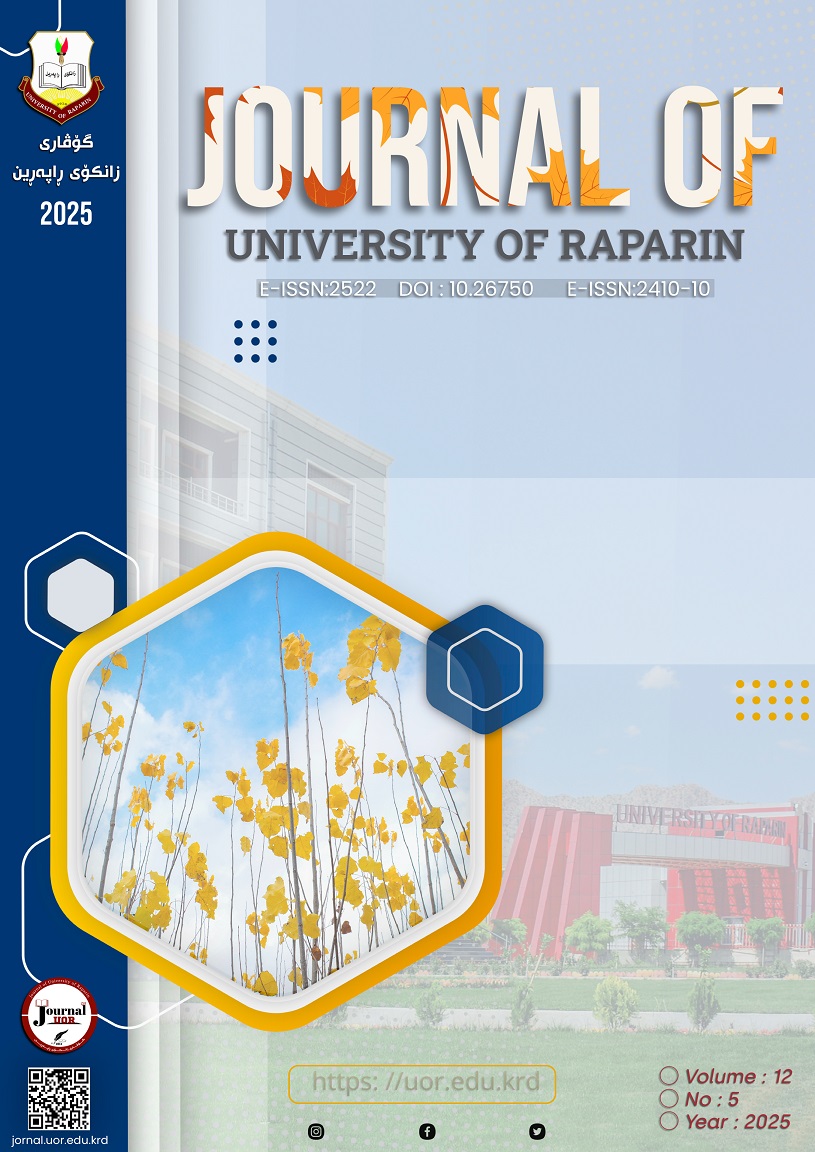Abstract
The theme is the most explicit component of a text, usually a poet or novelist writes a literary piece because of his/her point of view on a subject, which we call theme, and this shows the value of theme in literary genres. In the text, the theme has a strong relationship and is directly related to the character. Also, the theme can be expressed through both dialogue and monologue techniques. these don’t mean that a novelist doesn't use other techniques to manifest the novel's theme. The novel's theme could be expressed throughout a sentence, paragraphs, scenes, or events. If it is shown in a sentence, the novelist makes all elements and techniques of the text to serve the idea of the theme. Sometimes the text's theme is present in most parts of the text, the novelist expresses it in different ways and styles.
This research is entitled “The Theme of the Novel Bnuse Khween” Jebar Jemal Xerib’s novel. The method of this research is the Thematic Method. The novel contains many motifs like love, hate, tolerance, revenge...etc. In this research we clarified that doubt is the theme of the novel, it is present in the whole text and connected with many elements and techniques, despite that, most major and minor characters do not trust each other.
References
احمیانى، لیلى (٢٠١٤)، التيمة: اشكالية المصطلح وامتداداته، الحوار المتمدن-العدد: 4505 - المحور: الادب والفن.
بڵشن ئەدوارد، بتفاید، دایاناداو (١٩٨٢)، ڕۆمان و پیشەى نوسینى ڕۆمان، و. ئەژى گۆران، دەزگاى ڕۆشنبیرى و بڵاوکردنەوەى کوردى، بەغدا.
جەمال غەریب، جەبار (٢٠٢١)، بنوسە خوێن، چاپى دوەم.
رضايى، عربعلى (1382)، واژگان توصيفى ادبيات، تهران، فرهنگ معاصر، تهران.
روحانى، ماجد مردوخ (١٣٨٧)، فرهنگ فارسى-کردى دانشگاه کردستان، جلد سوم ع-ى، سنندج، چاپ اول.
عبدالرحیم، عبدالوهاب عبدالله (٢٠١٨)، ثيمات مقالات الدكتور محمود احمد السيد، گۆڤارى زانکۆى گەرمیان، Volume 5, Issue 1.
قەرەداخى، عەتا (٢٠١٧)، گەڕان لەنێوان واقیع و خەیاڵدا، دەزگاى چاپ و پەخشى سەردەم، کوردستان-سلێمانى.
یونسى، ئیبراهیم (٢٠٠٥)، گوڵبژێرێک لە هونەرى چیرۆک نوسین، و. نەبەز جەهانگیر پور، چاپەمەنى چوارچرا، چاپى یەکەم، سلێمانى.
یونسی، ابراهیم (١٣٨٦)، هنر داستان نویسى، مۆسسە انتشارات نگاه، چاپ نهم، تهران.
Griffith, Kelley (2010), Writing Essays about Literature (8 ed.), Cengage Learning, p. 40, ISBN 1428290419, retrieved February 10, 2013
Hauge, Michael (2015) Story and script consultant (Writing Screenplays That Sell)
Hornby AS (2005) Oxford Advanced Learner’s Dictionary of Current English, Oxford University Press.
J.A. Cuddon (1979), A dictionary of literary terms, Penguin Books.
Karadaghi, Rashid (2012), The Azadi (English-Kurdish) Dictionary, Third Edition.
Laurence, perrine, (2018) Literature (https://repository.maranatha.edu/6103/3/0141132_Chapter1.pdf)
MILLER-LINDY (2001), Mastering Practical Criticism, PALGRAVE, First Published.
Pinault, David (1992), Story Telling Techniques in the “Arabian Nights”, Studies in Arabic Literature.
Wiehardt, Ginny (2017), Themes in Literature, Updated November
Bushnell, J.T., Novelist and Oregon State University Senior Lecturer in What is a Theme in Literature. https://liberalarts.oregonstate.edu/wlf/what-theme)
Letourneau, Sara (2014),What is Theme, and Why is it Important? (https://diymfa.com/writing/theme-important/)
(McConnell, Scott (2019) , Storytelling And The Importance of Theme) December, https://www.creativescreenwriting.com/storytelling-and-the-importance-of-theme/

This work is licensed under a Creative Commons Attribution-NonCommercial-NoDerivatives 4.0 International License.
Copyright (c) 2025 Journal of University of Raparin

